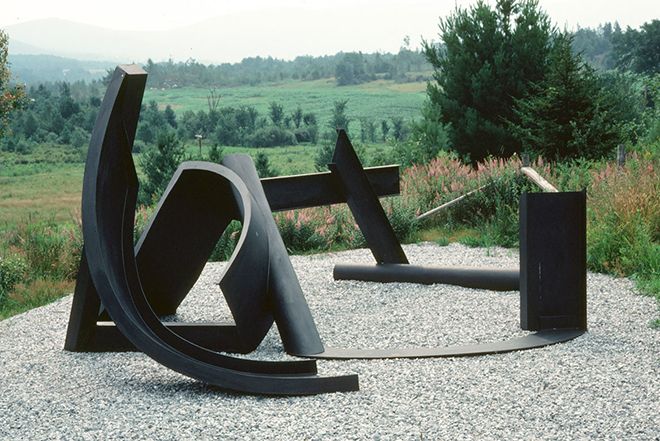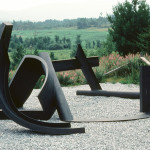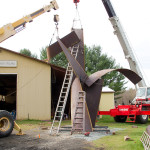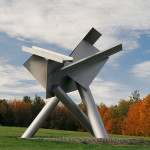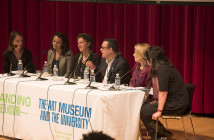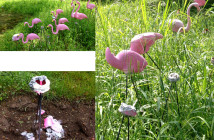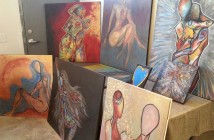As culture becomes increasingly networked, seemingly juxtaposed movements — the emphasis on cultural production rooted in place and localism, on one hand, and the turn toward more borderless cultural encounters, on the other hand — frequently come into contact. The recently opened Cold Hollow Sculpture Park, a property of rolling meadows in Enosburg Falls, Vermont, owned by sculptor David Stromeyer and his wife, suggests one artist’s approach to balancing these elements. The property, where Stromeyer and his wife, Sarah, spend their summers, features roughly fifty of Stromeyer’s large-scale sculptures set in the stunning Vermont scenery in which he works — a unique entry point to both the process and products of an artist whose practice operates in multiple networks.
The rural Vermont site has been central to Stromeyer’s practice since he bought it decades ago after studying topographical maps to find features that would allow for his expansive process. Its opening as a public sculpture park allows visitors a level of access to this ongoing practice, offering a rare chance to see works as parts of a sited process rather than as objects of display in more typical museum and gallery settings. Discussing his practice, Stromeyer remarks, "I’ve been trying to improve the land and add back to it," and this impulse is seen in works that encompass a range of forms and materials, with an emphasis on efficient, harmonious movement. Seeing the sculptures spread throughout the landscape, forming conversations with each other and the terrain, is a distinctive experience that invites exploration and engagement with the materially, structurally, and conceptually diverse works that spread across the property.
At the same time, however, the sculptures are not meant to be site-specific, and Stromeyer hopes to continue to expand his involvement in the broad networks of art markets and dialogue around sculpture. While Stromeyer has exhibited work in a range of institutions and has completed public commissions across the country, his career has not been located in the highly networked settings of a university or a major city. For both Stromeyer and the wider public, deepening his work’s role in these networks’ conversations and opening access to the processes that drive his work (and which draw from everything from anthropology to mathematics) offer a range of opportunities. However, given the remote location of Cold Hollow, the seeming challenges of this aim loom large: how does one find balance between the inherently rooted nature of this rural site and the interwoven networks of markets, tourism, and sculptural display that will shape how the park is accessed and used by the public?
In many ways, the opening of Cold Hollow to the public feels like an organic approach to balancing these divergent elements. The park largely offers an entry point to Stromeyer’s work, providing little structure other than a lightweight guide and some materials available in a barn near the entrance — rather than directing visitors’ interactions with the sculptures, the park offers orientation and an invitation to explore. The mention of picnic supplies on the park’s website is telling: visitors are welcome to partake in the evolving use of the land, interacting not with individual sculptures as static objects but with the landscape more holistically. Stromeyer’s studio, while not generally open to the public for safety reasons — Stromeyer works with an array of machinery, much of which he makes himself, to construct his work — composes part of this landscape. This simultaneous rootedness and movement makes the visitor experience notably distinct from the experience of visiting a museum or the kind of setting in which one usually encounters large-scale sculpture.
The place is always in flux — sculptures move around or leave the property, hay grows and alters the paths that snake between sculptures — and visitors’ movements feel like part of this process, rather than being separate from the park’s displays. While visiting the site, I was struck by how rare it is to encounter such a general invitation to see process, rather than product, in this manner. As Stromeyer notes, outside of museums and public spaces, interactions with large sculpture are largely confined to an elite collecting and curatorial base. By opening access to Cold Hollow, Stromeyer allows a wider swath of people not only to interact with his sculptures, but to see an art practice play out and to engage with the various processes that drive artistic production and exchange. It is precisely these processes that are often obscured when we only see artwork, particularly large and sometimes intimidating sculpture, in museums, galleries, and cold plazas, and allowing for deeper engagement with sculpture seems to be a primary value of the approach Stromeyer has taken to Cold Hollow.
Of course, communicating this value is made more challenging by the park’s location, which raises questions of accessibility and reach. Aware of this, the small Cold Hollow launch team is working to both draw from and contribute to local networks to make the park more accessible to broad publics. The park’s website offers suggestions for local hotels, restaurants, and cultural offerings, and Stromeyer and others are working with a range of local stakeholders to forge loose partnerships that raise awareness of the region’s resources among locals and visitors alike. Furthermore, Stromeyer will be collaborating with Burlington City Arts on this year’s iteration of Of Land and Local, which unites artists, farmers, and other Vermonters in explorations of "the notion that culture helps define place, but also that place plays a significant role in establishing culture." For a site both rooted in geography and involved in wide-ranging networks, this approach — which links distinct artistic and agricultural processes through their generative interactions with landscapes — is a natural fit. Both for Vermont residents and for tourists, linking Cold Hollow to sites of cultivation and creativity throughout the region creates a larger array of entry points to the sculpture park, tempering some of the remoteness of its location.
Going forward, Stromeyer sees opportunities to both deepen his involvements in these local networks and to expand the interactions and experiences that take place at Cold Hollow. His ideas include residency programs, visiting sculpture rotations, and convergences of writers, artists, and others who would bring a range of processes and perspectives to the land. These ideas suggest numerous possibilities for a space that aims to be both locally rooted and involved in the intersections of markets, tourism, dialogue, and creation. In describing his sculptural process, Stromeyer explains, "I start with a vision, then figure out ways of doing things." This approach seems to extend to the opening of Cold Hollow: with a vision that emphasizes both broader and deeper engagement, Stromeyer and Cold Hollow are moving forward organically, inviting people to explore an existing process and to participate in the processes that will shape interactions with the land and its products within and beyond the park’s physical space. Both for those familiar with artistic processes and for publics who generally see the products of artmaking only in highly specific contexts, this model offers an intriguing — and potentially very generative — mode of engaging with artwork.
- Cold Hollow Sculpture Park.
- Cold Hollow Sculpture Park.
- Cold Hollow Sculpture Park.

